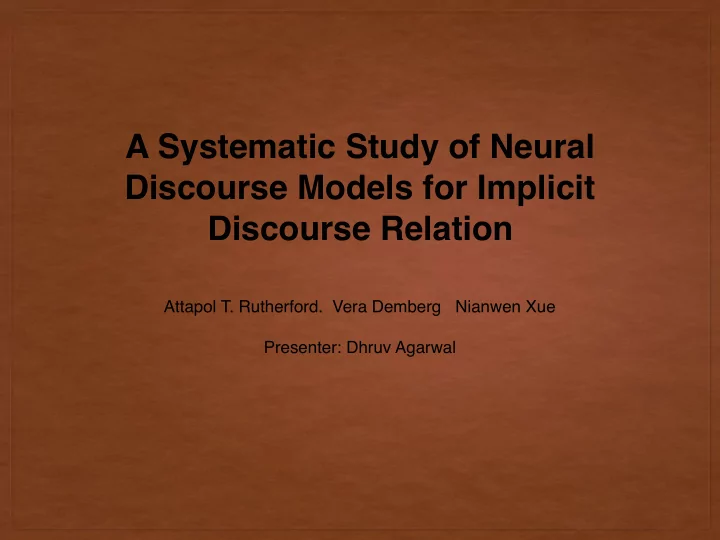

A Systematic Study of Neural Discourse Models for Implicit Discourse Relation Attapol T. Rutherford. Vera Demberg Nianwen Xue Presenter: Dhruv Agarwal
INTRODUCTION • Inferring implicit discourse relations is a difficult subtask in discourse parsing. • Typical approaches have used hand crafted features from the two arguments and suffer from data sparsity problems. • Neural network approaches need to be applied on small datasets and possess no common experimental settings for evaluation. • This paper conducts several experiments to compare various neural architectures in literature and publishes their results.
DISCOURSE • High level organization of text can be characterized as discourse relations between adjacent pairs of texts. • There are two types of discourse relations: • Explicit Discourse Relations • Implicit Discourse Relations
EXPLICIT DISCOURSE According to Lawrence Eckenfelder, a securities industry analyst at Prudential-Bache Securities Inc., "Kemper is the first firm to make a major statement with program trading." He added that "having just one firm do this isn't going to mean a hill of beans . But if this prompts others to consider the same thing, then it may become much more important .” The discourse connective is ' but ', and the sense is Comparison.Concession
IMPLICIT DISCOURSE According to Lawrence Eckenfelder, a securities industry analyst at Prudential-Bache Securities Inc., "Kemper is the first firm to make a major statement with program trading ." He added that "having just one firm do this isn't going to mean a hill of beans . But if this prompts others to consider the same thing, then it may become much more important." The omitted discourse connective is ' however '. and the sense is Comparison.Contrast .
CHALLENGES • Predicting internal discourse relations is fundamentally a semantic task and relevant semantics might be difficult to recover from surface level features. Bob gave Tina the burger. She was hungry. • Purely vector based representations of arguments might not be sufficient to capture discourse relations. Bob gave Tina the burger. He was hungry.
MODEL ARCHITECTURES • In order to find the best distributed representation and network architecture , they explore by probing the different points on the spectrum of structurality from structureless bag-of-words models to sequential and tree-structured models. • Bag of words Feed Forward Model • Sequential LSTM • Tree LSTM
FEED FORWARD MODEL THREE KINDS OF POOLING ARE CONSIDERED: MAX, MEAN AND SUMMATION AS FOLLOWS,
SEQUENTIAL LSTM
TREE LSTM • THE DIFFERENCE BETWEEN STANDARD LSTM AND TREE LSTM IS THAT GATING VECTORS AND MEMORY CELL UPDATES ARE BASED ON HIDDEN STATES OF MANY CHILD NODES. • THE HIDDEN STATE VECTOR CORRESPOND TO A CONSTITUENT IN THE TREE.
IMPLEMENTATION DETAILS • Penn Discourse Tree Bank is used because of its theoretical simplicity and large size. • The PDTB provides three levels of discourse relations, each level providing finer semantic distinctions. • The task is carried out on the second level with 11 classes. • Cross Entropy Loss function, Adagrad Optimizer and no regularization/dropout. • The model performance is also evaluated on CONLL shared task 2015 and CDTB.
RESULTS • FEEDFORWARD MODEL IS THE BEST OVERALL AMONG ALL THE NEURAL ARCHITECTURES THEY EXPLORE. • IT OUTPERFORMS LSTM BASED,CNN BASED AND THE BEST MANUAL SURFACE FEATURE BASED MODELS IN SEVERAL SETTINGS.
• For Baseline comparison Max Entropy models are used which are loaded with feature sets such as dependency rule pairs, production rule pairs and Brown Cluster pairs.
• Sequential LSTMs outperform feedforward model when word vectors are not high dimensional and not trained on a larger corpus. • Summation pooling is effective for both LSTM and feedforward models, since word vectors are known to have additive properties.
DISCUSSION • Sequential and Tree LSTM might work better if they had a larger amount of annotated data. • Benefits of Tree LSTM cannot be realized if the model discards syntactic categories in intermediate nodes. • Linear interaction allows combination of high dimensional vectors without exponential growth of parameters.
CONCLUSION • Manually crafted surface features are not important for this task and it holds true for different languages. • Expressive power of distributed representations can overcome data sparsity issues of traditional approaches. • Simple feed-forward architecture can outperform more sophisticated architectures such as sequential and tree-based LSTM networks, given the small amount of data. • The paper compiles the results of all the previous systems and provides a common experimental setting for future research.
THANK YOU
Recommend
More recommend